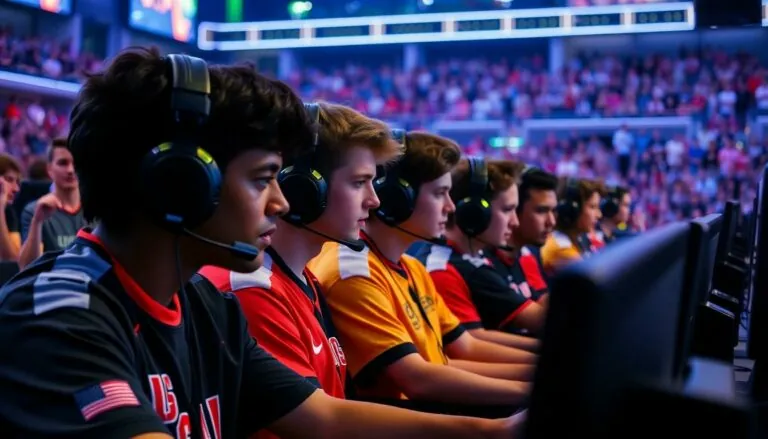In the frosty winter of 2013, something monumental happened in the world of esports. Gamers everywhere were not just battling for glory but also for a chance to unlock the coveted Winter Case. Imagine a treasure chest filled with the most dazzling skins and rare items, all waiting to be discovered. It wasn’t just about the thrill of the game; it was about the excitement of what lay inside that virtual box.
The 2013 Winter Case didn’t just add a sprinkle of holiday cheer to the gaming community; it transformed the way players approached their favorite titles. As they opened cases, the anticipation was palpable. Would they strike gold or just end up with another basic skin? Join the journey through this iconic moment in esports history and discover why the Winter Case still holds a special place in the hearts of gamers everywhere.
Table of Contents
ToggleOverview of Esports 2013 Winter Case
The Winter Case marked a pivotal moment in esports, specifically in the gaming community surrounding titles like CS:GO. Introduced in December 2013, players eagerly anticipated the chance to unlock unique skins and rare items through this virtual treasure chest. The excitement surrounding these cases significantly altered player engagement and interaction, as participants hoped to acquire valuable items that could enhance their gameplay experience.
This case featured 16 new skins, showcasing vibrant designs and various themes. Notable skins included the AWP
| Redline and the AK-47 |
The Empress, which quickly became fan favorites. Many players sought after these aesthetics for their rarity and appeal, fueling a competitive market for both trades and sales.
The mechanics of opening cases also added an element of surprise, allowing players to take a risk in hopes of gaining desirable items. Players felt a rush of adrenaline with each case opening, as the potential to obtain high-value items created excitement within the community. Consequently, the economic impact of this case influenced in-game item trading, leading to fluctuations in market prices for sought-after skins.
The introduction of the Winter Case not only marked a change in how players experienced games but also contributed to the monetization of gaming through microtransactions. This shift reflected broader trends in the gaming industry, where aesthetic items generated substantial revenue streams. The adjustments made in response to player feedback outlined how the gaming community shaped its evolution.
Overall, the 2013 Winter Case remains a cornerstone in discussions about esports and game development, showcasing how virtual items can transform player engagement and the industry’s economic landscape.
Key Features of the Winter Case
The Winter Case stands out for its unique offerings in the esports landscape. This digital treasure chest introduced players to an exciting array of skins and items.
Game Titles Included
The Winter Case featured skins applicable across several popular titles. Players found skins for games like Counter-Strike: Global Offensive (CS:GO) among its contents. Notably, it included skins designed specifically for weapons in CS:GO, enhancing the overall gameplay experience. The case expanded the game’s aesthetic appeal, making it a significant addition to the player community.
Notable Skins and Items
Among the standout items were the AWP
| Redline and AK-47 | The Empress. Each skin brought a distinct visual style that captured players’ attention. Fans celebrated the unique designs and rarity of these skins, creating a buzz within the trading community. Additionally, the AWP | Redline exemplified the sleek and modern aesthetic while the AK-47 |
The Empress showcased intricate details. Such notable skins elevated the Winter Case’s value, encouraging engagement and competition among players.
Impact on the Esports Community
The introduction of the Winter Case in December 2013 significantly influenced the esports community. It transformed player experiences and shaped market dynamics.
Player Reactions
Players expressed excitement and enthusiasm as they anticipated opening the new Winter Cases. The unique skins generated buzz within the gaming community, leading to increased discussions on forums and social media. Rarity played a crucial role, as users hoped to obtain coveted items like the AWP
| Redline and the AK-47 |
The Empress. Emotional investment grew as gamers felt a connection to their favorite titles through these skins. The thrill of discovery became a shared experience, creating a sense of camaraderie and competitive spirit within the community.
Market Trends Post-Release
Post-release, the Winter Case heavily influenced market trends in esports. Prices for popular skins experienced fluctuations due to increased demand among collectors and players. Item trading became more frequent as gamers sought to capitalize on market opportunities. The rise of secondary trading platforms emerged, catering to players eager to buy, sell, and trade rare items. This demand for unique skins boosted the virtual economy, aligning with broader industry trends focused on microtransactions and in-game purchases. The Winter Case notably solidified the economic framework of the esports market, demonstrating the enduring value of virtual items.
Comparison with Previous Cases
The introduction of the Winter Case in 2013 marked a pivotal moment in esports, especially when compared to earlier case releases. Previous cases lacked the same level of anticipation and excitement, often featuring fewer skins and less variety. The 2013 Winter Case included 16 new skins, creating a more vibrant selection for gamers than earlier versions that offered limited choices.
Notably, skins like the AWP
| Redline and AK-47 |
The Empress stood out for their unique designs and rarity, unlike many prior items that failed to draw the same level of interest. Players experienced heightened emotions when opening these cases, contrasting with the more subdued reactions from earlier case releases. The adrenaline rush associated with unveiling a highly sought-after skin contributed to a more dynamic gaming experience that wasn’t as pronounced previously.
Market dynamics also shifted significantly with the Winter Case. Increased demand for the new skins led to substantial fluctuations in pricing, which hadn’t been as apparent before. Earlier cases did not foster the robust trading platforms that emerged post-Winter Case, where gamers eagerly bought, sold, and traded items. Discussions among the gaming community exploded on forums and social media platforms, driven by the excitement surrounding these new offerings.
With the Winter Case, the influence on monetization became evident as well. Previous cases simply laid the groundwork for microtransactions, while the 2013 Winter Case intensified the trend. Players engaged with the skins more emotionally, creating a sense of community and competition that outshone previous cases. Overall, the Winter Case significantly transformed player interactions and market behaviors, setting new standards for future esports initiatives.
Future Implications for Esports
The introduction of the Winter Case in December 2013 marked a transformative moment for esports. This event reshaped the gaming economy by significantly impacting item trading dynamics. Notably, the availability of legendary skins, like the AWP
| Redline and AK-47 |
The Empress, stimulated remarkable player engagement. Gamers developed a heightened preference for skins, creating a culture of anticipation and competition.
Increased market activity resulted from the adrenaline rush associated with opening cases. These mechanics encouraged players to participate actively, driving up demand for new skins. Additionally, fluctuations in market prices emerged as sought-after items became rare. A shift occurred in how players interacted with games, leading to the rise of trading platforms that greatly enhanced the esports ecosystem.
Developers recognized the financial potential of microtransactions. The monetization strategies adopted with the Winter Case established new benchmarks for future initiatives. Insights drawn from this event underline the importance of player-driven economies in esports, with community reactions shaping the development of new features. Consequently, a culture emerged valuing both aesthetic personalization and the competitive advantage of rare items.
Anticipation surrounding each new case release strengthened community bonds. Players now sought to showcase their unique collections, contributing to a sense of identity within the gaming world. Skins evolved into symbols of status, with traders meticulously analyzing market trends. Their efforts ensured the continued growth of the esports economy, demonstrating the long-term implications of the Winter Case.
Publishing companies began exploring innovative monetization models influenced by this case. As a result, the framework established by the Winter Case remains a reference for future developments in esports, showcasing how a single event can irreversibly change the landscape.
Conclusion
The 2013 Winter Case marked a turning point in esports by reshaping player engagement and the in-game economy. Its introduction not only captivated gamers with unique skins but also ignited a vibrant trading community. The excitement surrounding these virtual treasures created a rush that players eagerly anticipated.
This case’s influence extended beyond mere aesthetics, impacting market dynamics and establishing new standards for monetization through microtransactions. As players sought rare items, the Winter Case solidified its place in esports history, illustrating how a single innovation can drive significant change. The legacy of the Winter Case continues to resonate, shaping the future of player interactions and economic models within the gaming industry.







